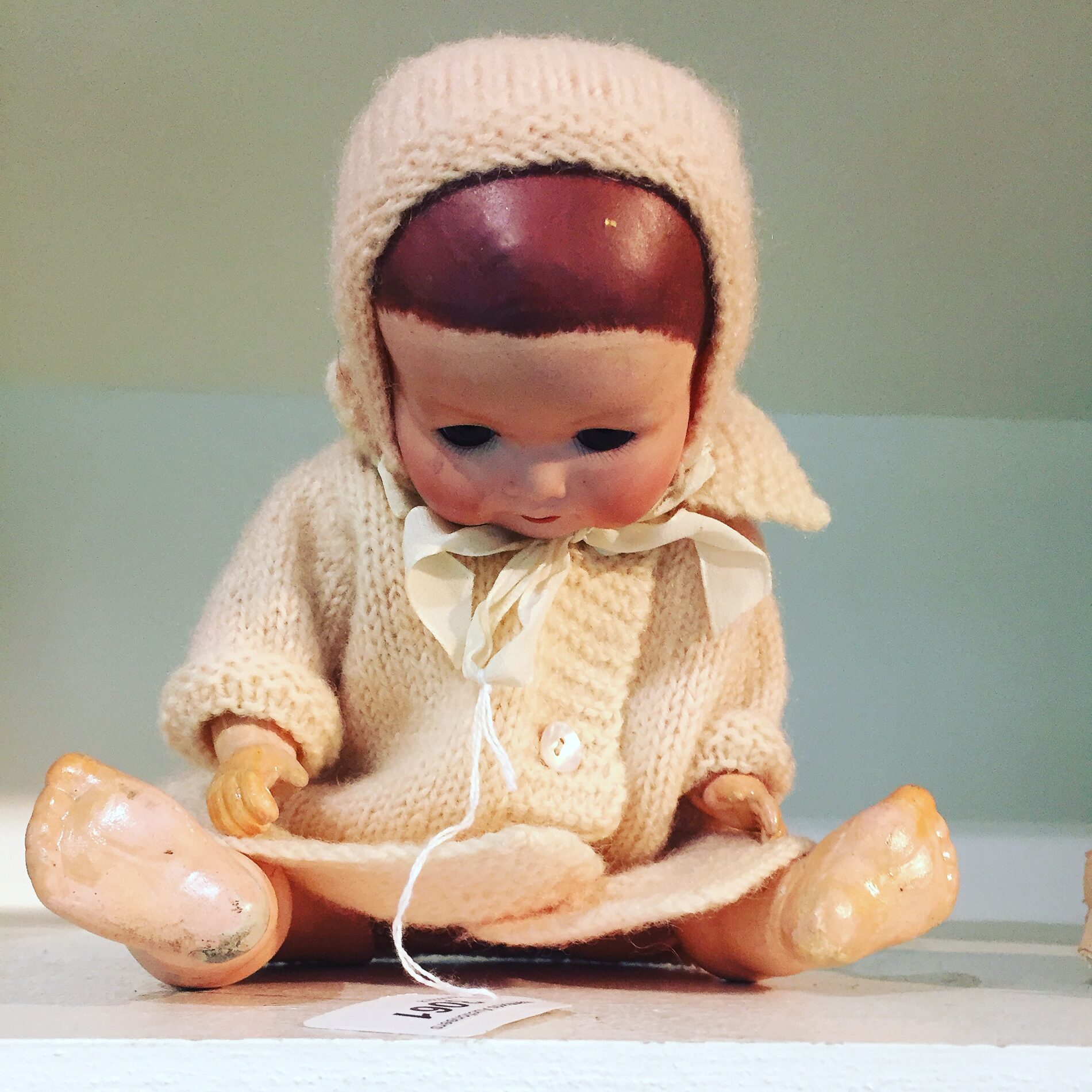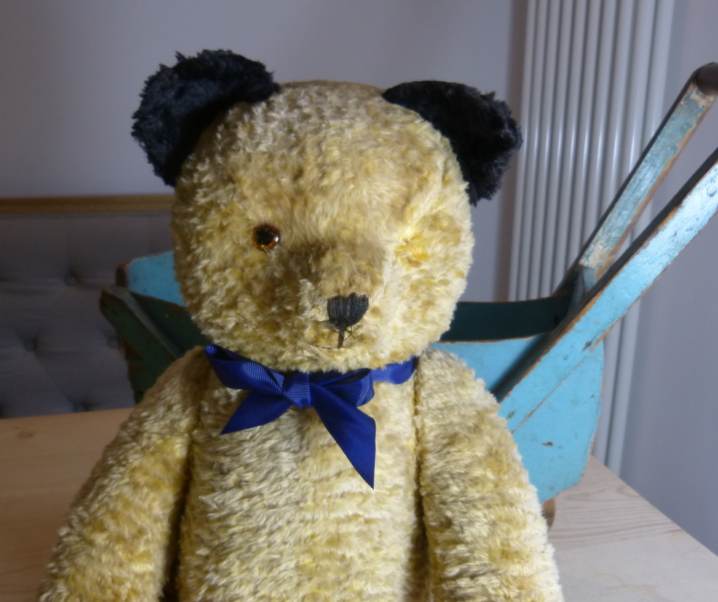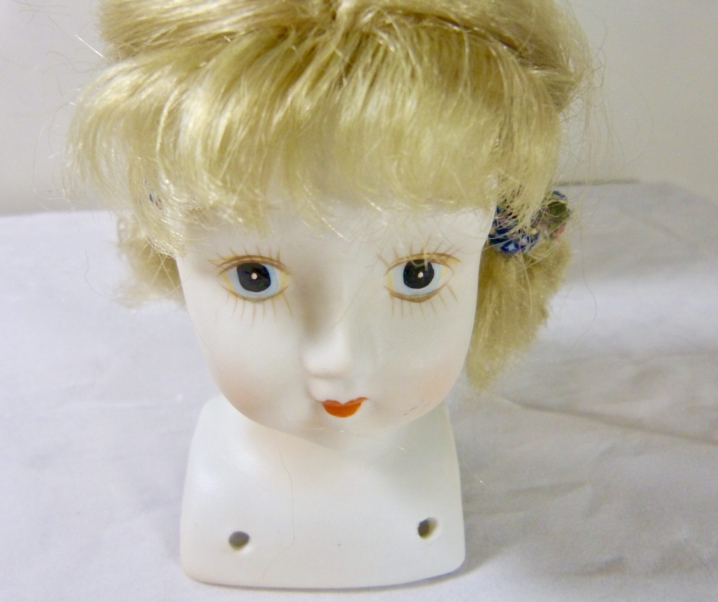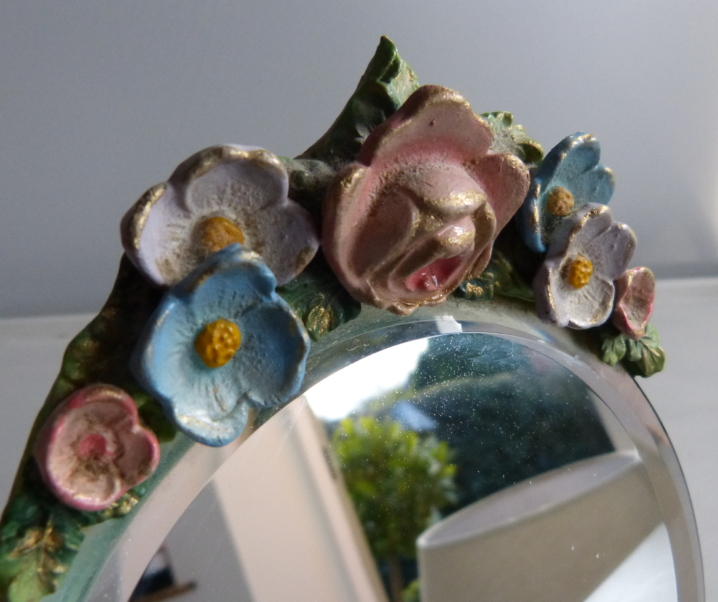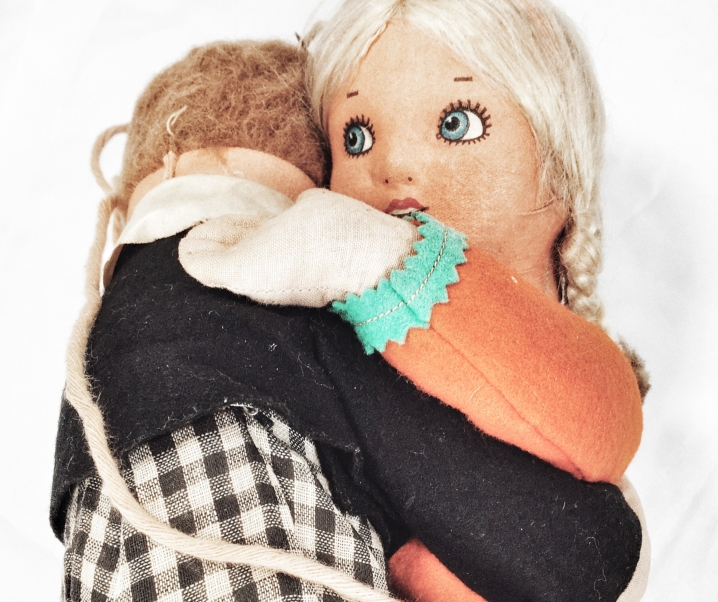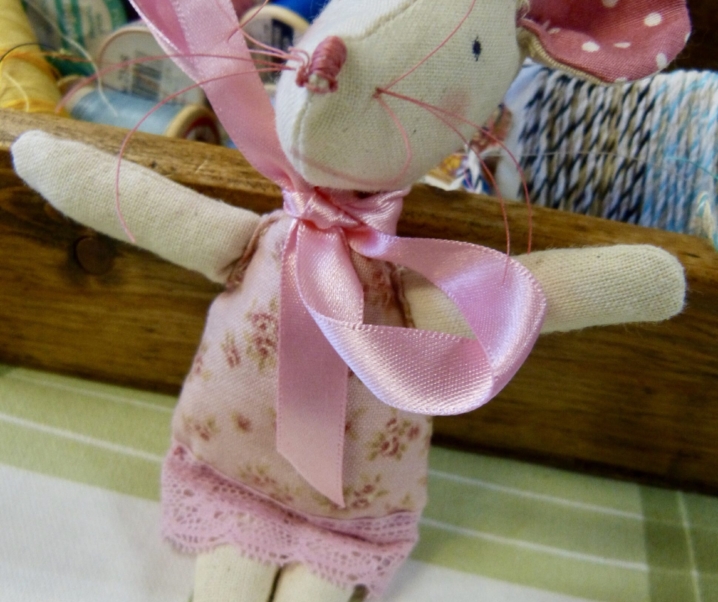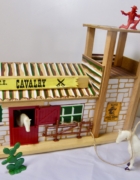“Lot 3105, a 19th Century wax shoulder dolls, black eyes…” announces the toy auctioneer at Bamfords in Derby.
“Just a second – it’s going bananas on the internet,”

‘Bananas’ refers to interest shown by absent bidders. Once a lot is introduced there can be flurry of live internet bids from anywhere in the world and the auctioneer – in this case Ian Crawford – can only sit and watch the price escalate on screen.
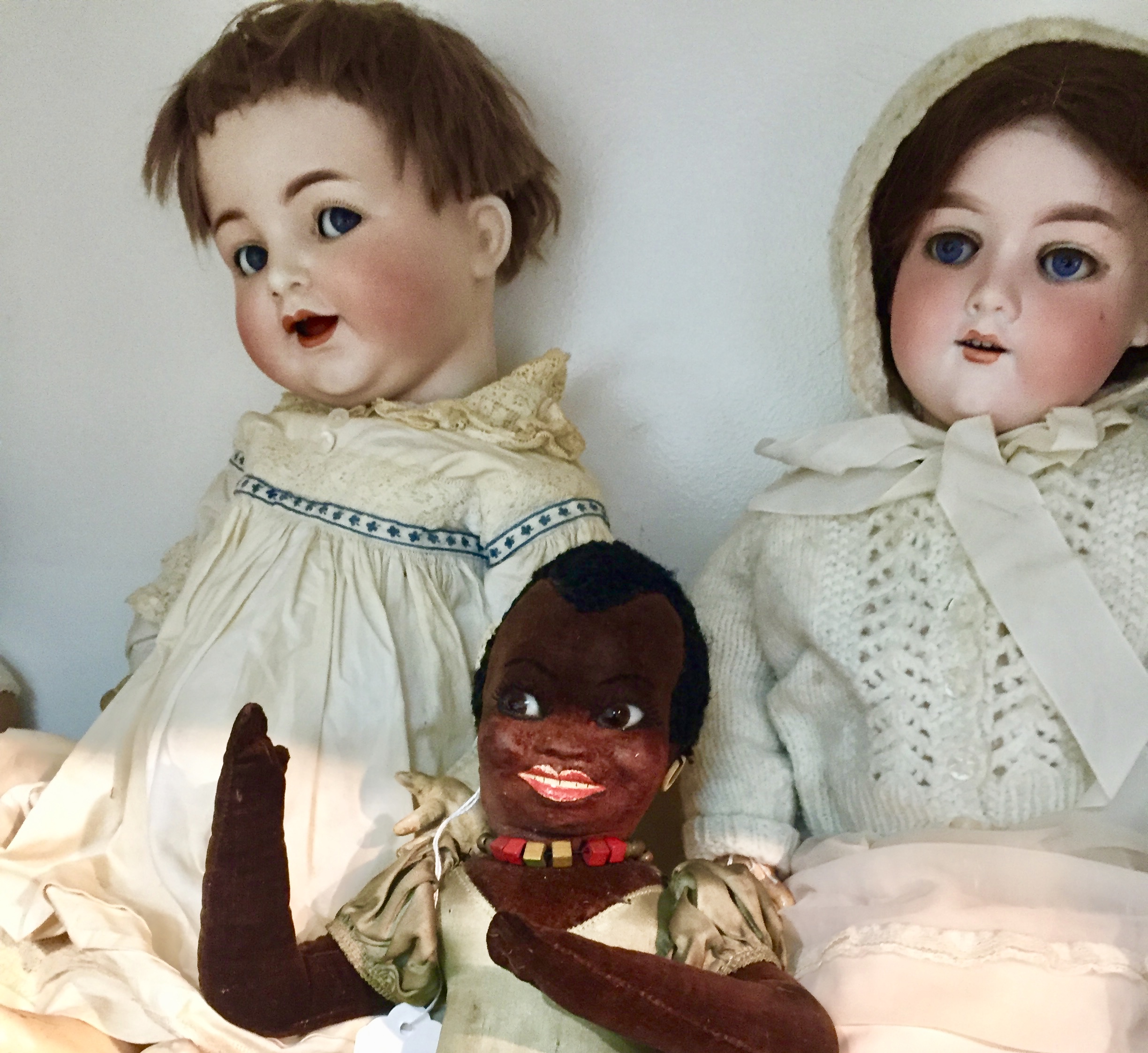
Only when the internet bidding has stalled, can the doll be offered to the dozen or so toy collectors in the room.
My heart is also going bananas. While I can understand how auctions work; I have no idea why one wax lady sells for £350 whereas the next wax offering achieves barely a flicker of interest and sells for a sluggish £45. It’s one of those unfortunate paradoxes; the more I find out about vintage dolls, the less I know.
But it’s all very exciting…
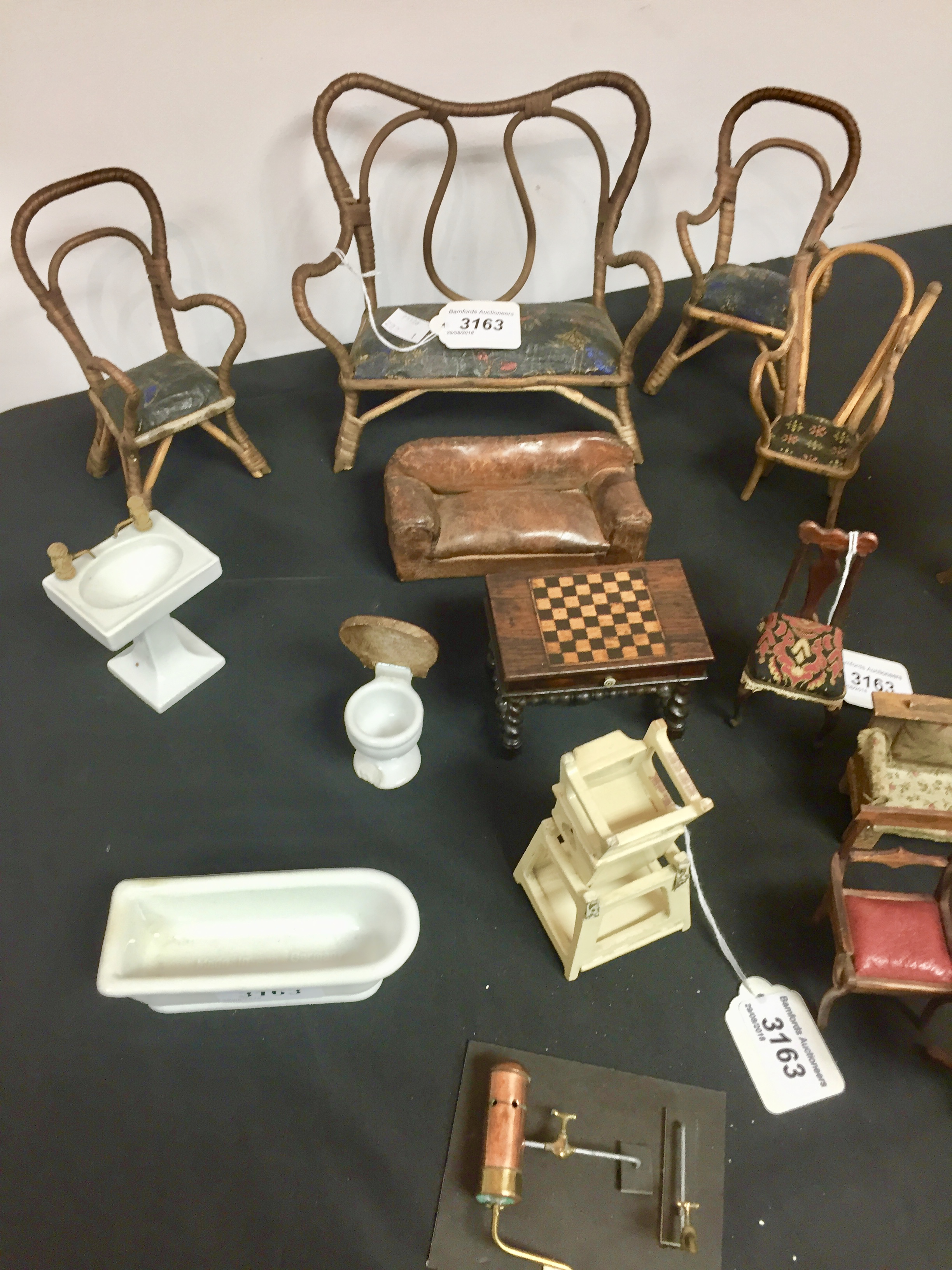
I pitched up at the Specialist Toy and Juvenalia Sale with £40 in my pockets in the hope of securing one of the lots of doll’s house furniture. It quickly became apparent that my pockets would need to be deeper.
Much deeper.
I opened the bidding at £30 on the first lot – some relatively modern plastic furniture – but decided to let it go to another for £35. I was confident I’d get a later – better – lot.
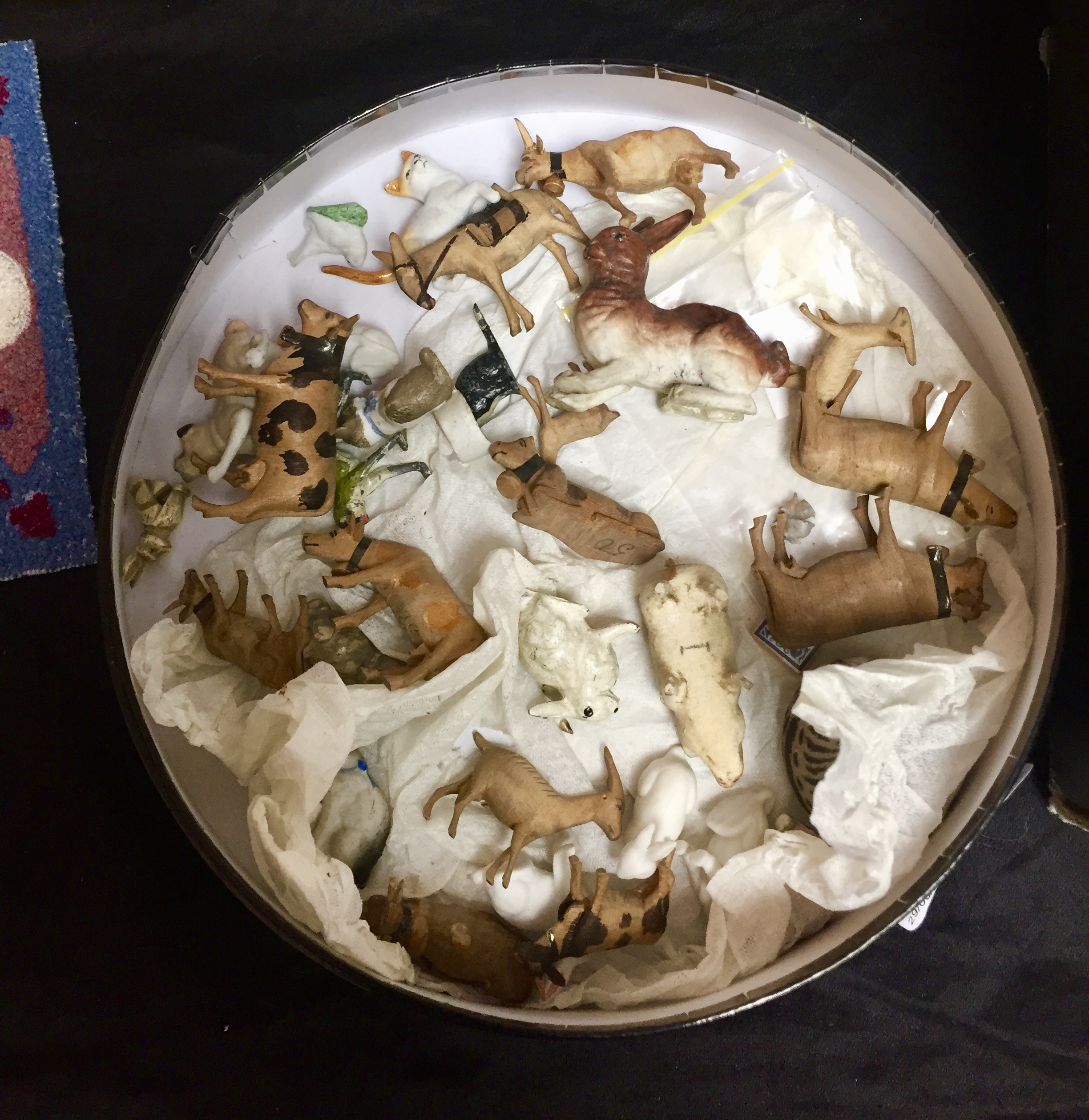
Subsequent dolls house furniture lots realise £180, £90, £100, £65 and £380 respectively – the last lot being a particularly interesting one containing two old Victorian miniature prams and a box of wooden animals (pictured above).
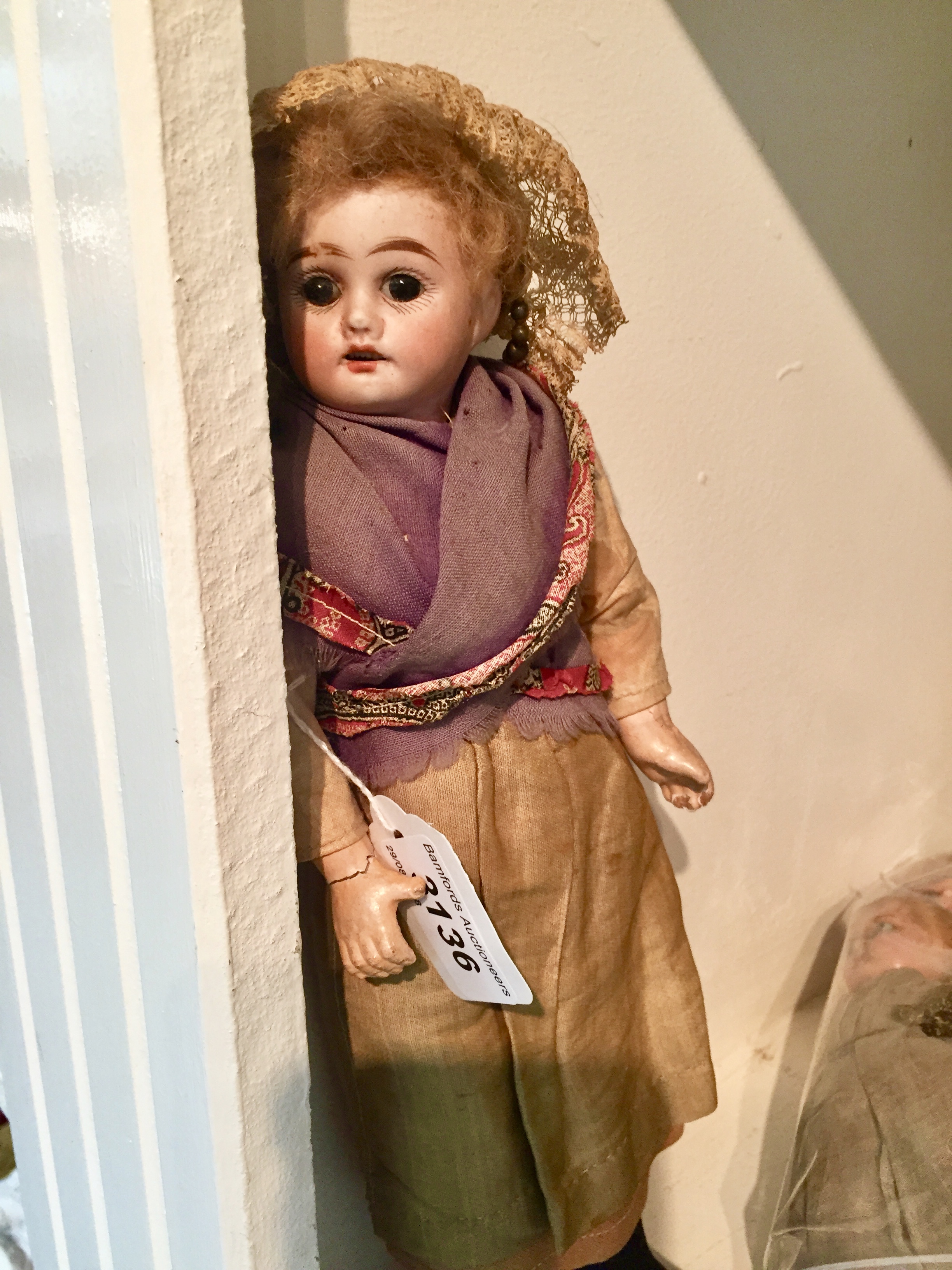
I have no idea what made these lots so desirable. Without specialist knowledge (research and experience) you’re really in the dark. This is especially true at a specialist auction where you are surrounded by experts who know that a trailing ‘F’ on a Steiff ear button means they’d found an early bear in a forest of reproductions.
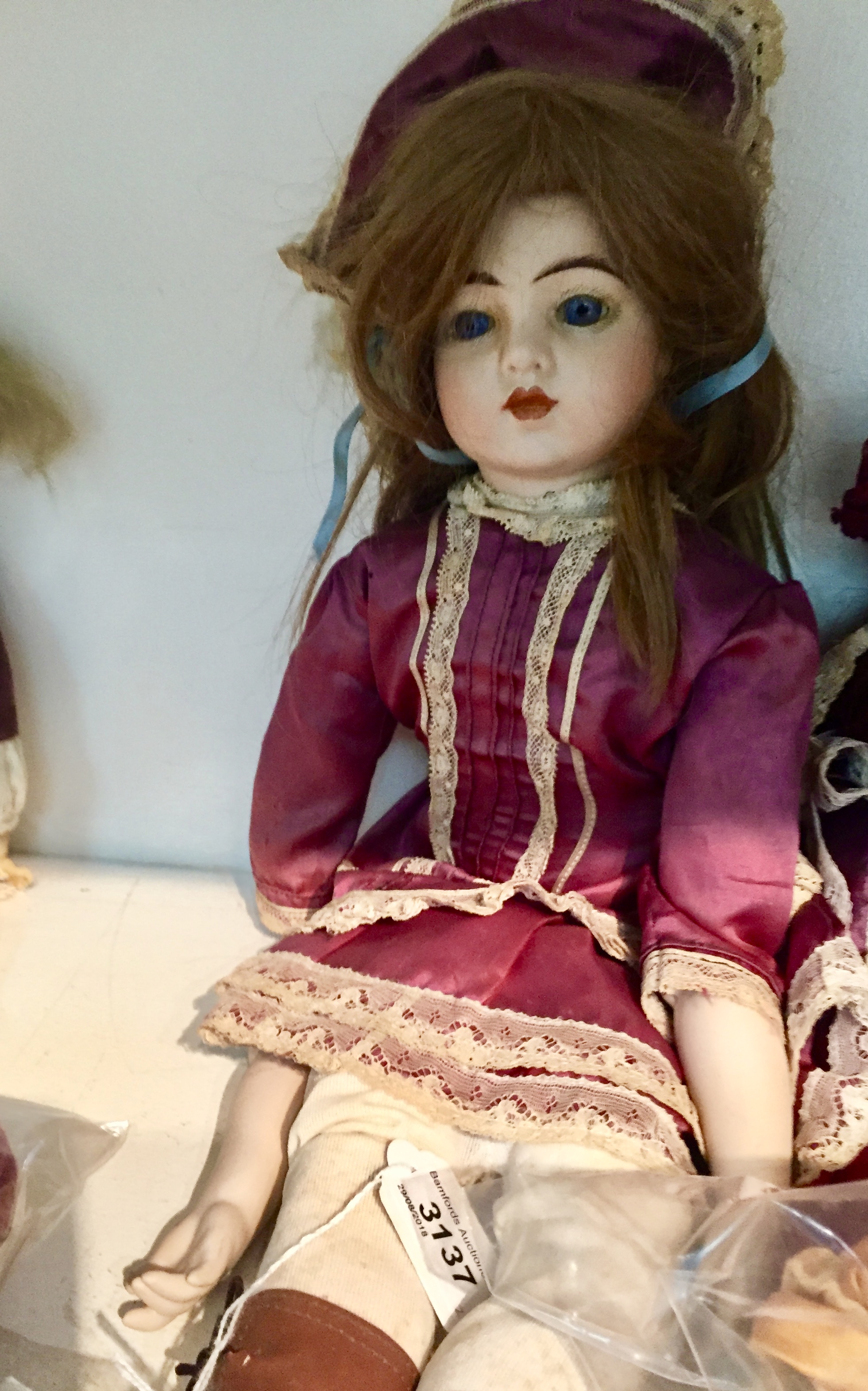
Over the course of two hours, I watch some very dirty, damaged and tatty-haired dolls exchange hands for hundreds of pounds. When the auction pauses for a much needed break, I approach one of the expert dolly dealers in the room for more information.

She agrees to help and – over the course of the next days – very patiently answers all of my questions. She does, however, ask to remain anonymous. Quite simply; doll trading is a bit like poker – you don’t want to reveal your hand (what you are buying/prepared to bid) to the other players.
I am going to call my contact ‘Mande’ which stands for My Anonymous Doll Expert’. According to Mande, the Bamfords Auction was a fairly typical auction.
“The selection included the higher-end, the low-end, the reproductions, the damaged, and everything in between,” she concludes.
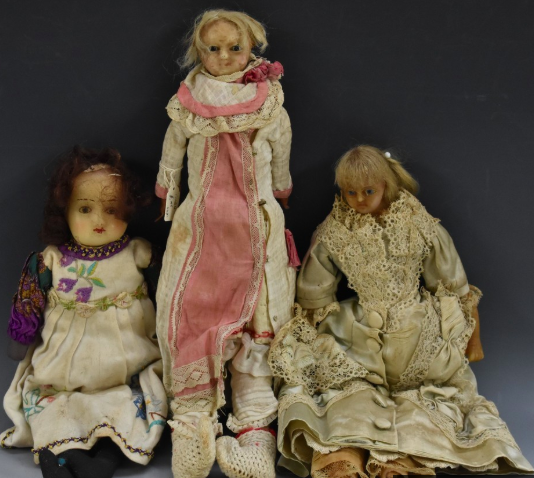
As for prices…
“Prices are stable and fairly low for the more commonly found dolls by Armand Marseille and Heubach Koppelsdorf – both mass produced in the early 1900’s and they’re more affordable then and now,” she explains.
“Like anything, there are the Rolls Royce and the Reliant Robin of dolls. The rarer, harder to find collectables and those perceived as high-end items by desirable makers will usually achieve a good price at auction.”
She agrees that some of the prices were over-inflated but has a theory. “If prices are high or inflated it’s because more affluent collectors are prepared to pay above market value for a rarity or a jewel of a doll they simply want and can afford.”
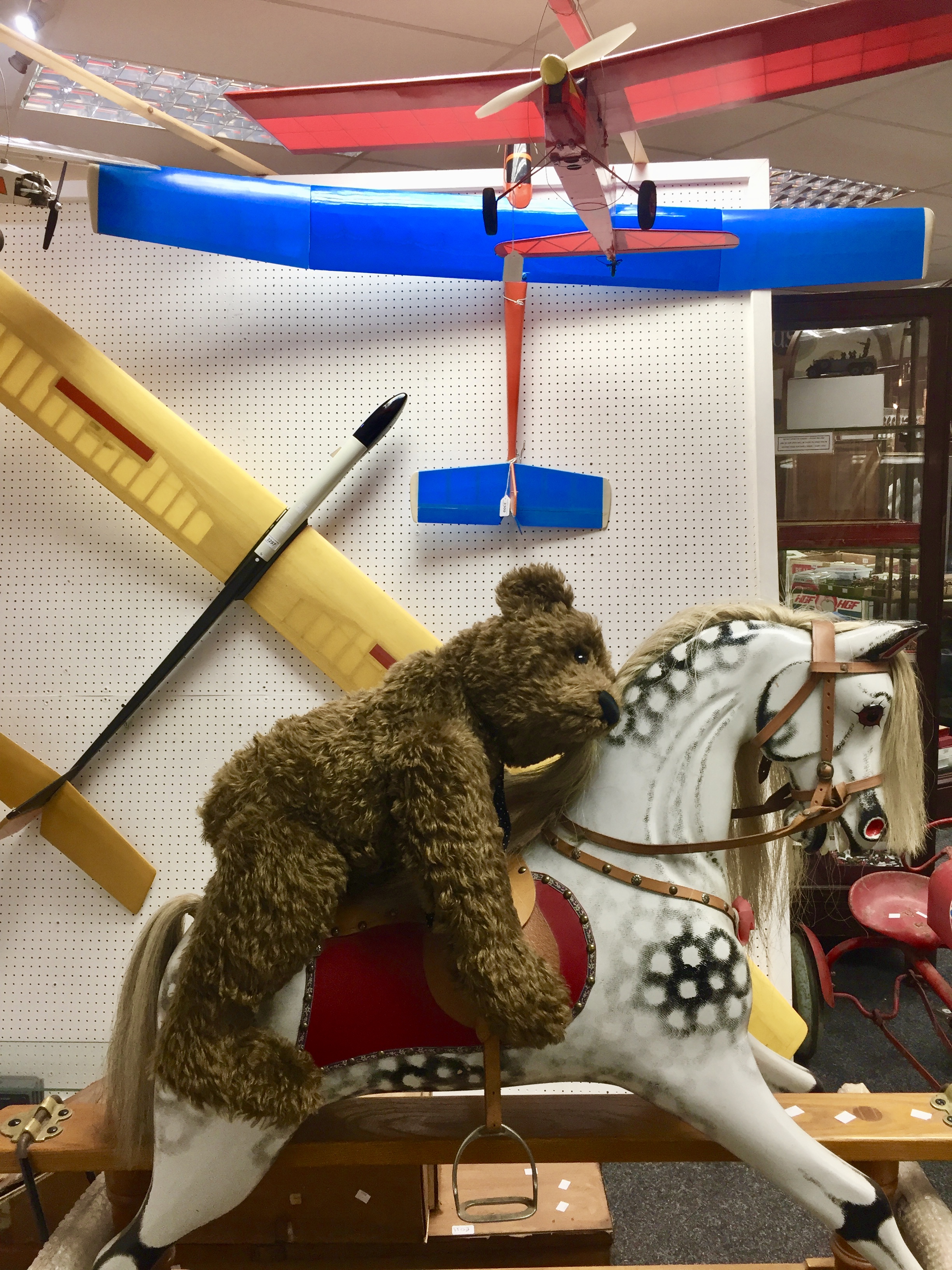
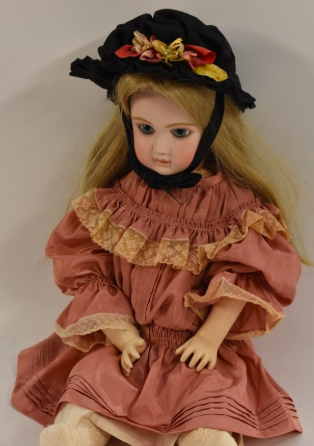
“While taste might be capricious; desirability is a factor, rarity is a factor, and condition is the biggest factor of all,” explains Jay Lowe of Morphy Auctioneers in Denver.
“I use the phrase ‘Condition is king.’ ”
Mande agrees; “The most desirable high end dolls weathered the recent dip in prices. Some lost very little in value at all,” she says.
“French dolls by Jumeau or Ferdinand Gaultier for example, English Queen Anne era, early German Grodnertal wooden dolls and French mignonettes with the swivel heads and slender limbs. There is also a growing interest and investment in vintage dolls that are not old enough to be classed as antique. These include Sasha dolls, Sindy, Action Man and Barbies etc. The rise in price is down to collectors who remember certain dolls from their childhoods. A good Pippa doll, boxed and in mint condition, can fetch £300 on a good day.”
I confess to Mande that I am finding it all a bit of a minefield. She kindly extends some general tips – which I have included under the pictures – and offers some wise words of consolation.
“The antique doll trade is a very complex one – there is SO much to learn in the field because there are so many makers and types,” she says.
“Luck plays a big in buying at auction too – so good luck.”
Jolly Volley attended Bamfords Specialist Toy and Juvenalia Sale on August 29th 2018 in Derby.
The following ten lots – with their catalogue descriptions – were some of the more interesting dolly deals of the day. Jolly Volley looks at the history of the individual dolls and reveals their final hammer price.
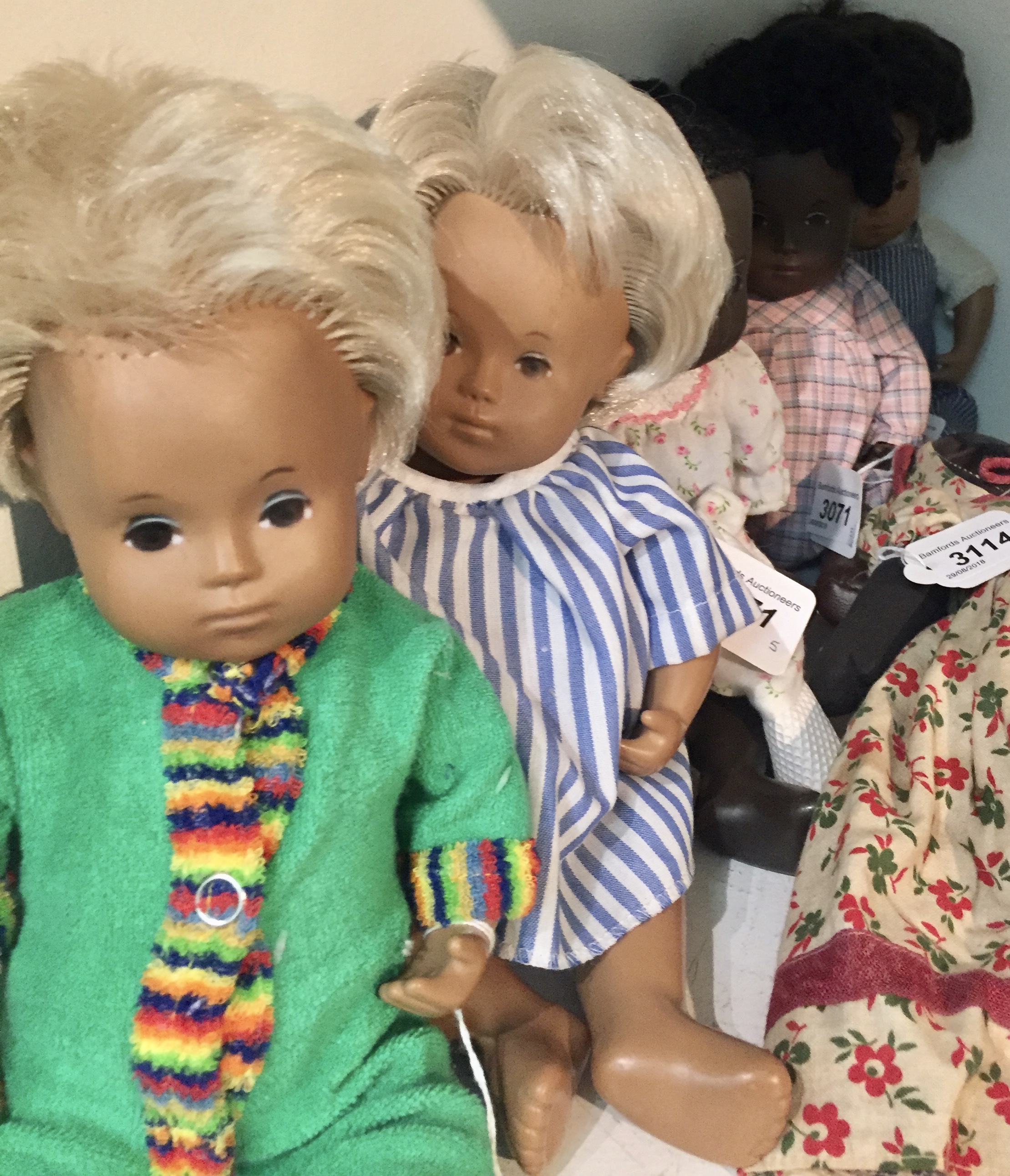
Lot 3071
“A Trendon Sasha Baby, with white hair, green towelling baby grow; others, various – five dolls.”
Trendon Ltd was the English company entrusted with making the stunning “Sasha” dolls made by Swiss artist Sasha Morgenthaler. Sasha travelled the world, meeting lots of children, and they inspired her to make dolls.
One-of-a-kind, handmade, expensive dolls.
Which is why Sasha sanctioned the production of an affordable doll into two factories; Götz-Puppenfabrik in Germany and Trendon, Cheshire.
It’s easy to tell them apart as the English dolls are unmarked. The dolls were made from vinyl with rooted hair (limited edition had wigs) and all had the distinctive ‘Sasha doll’ look. Ironically, the dolls were made so all girls could buy one to play with, but they’re now becoming expensive collectables. There were nine other (individual) Trendon Sasha dolls at the auction and they sold for between £45-90. These English dolls were produced between 1966-86 and, as such, they are a good example of a non-vintage doll which is capable of trouncing an antique counter-part.
Nostalgia can make for a very expensive hobby.
Estimate; £60-100
Sold for; £150*
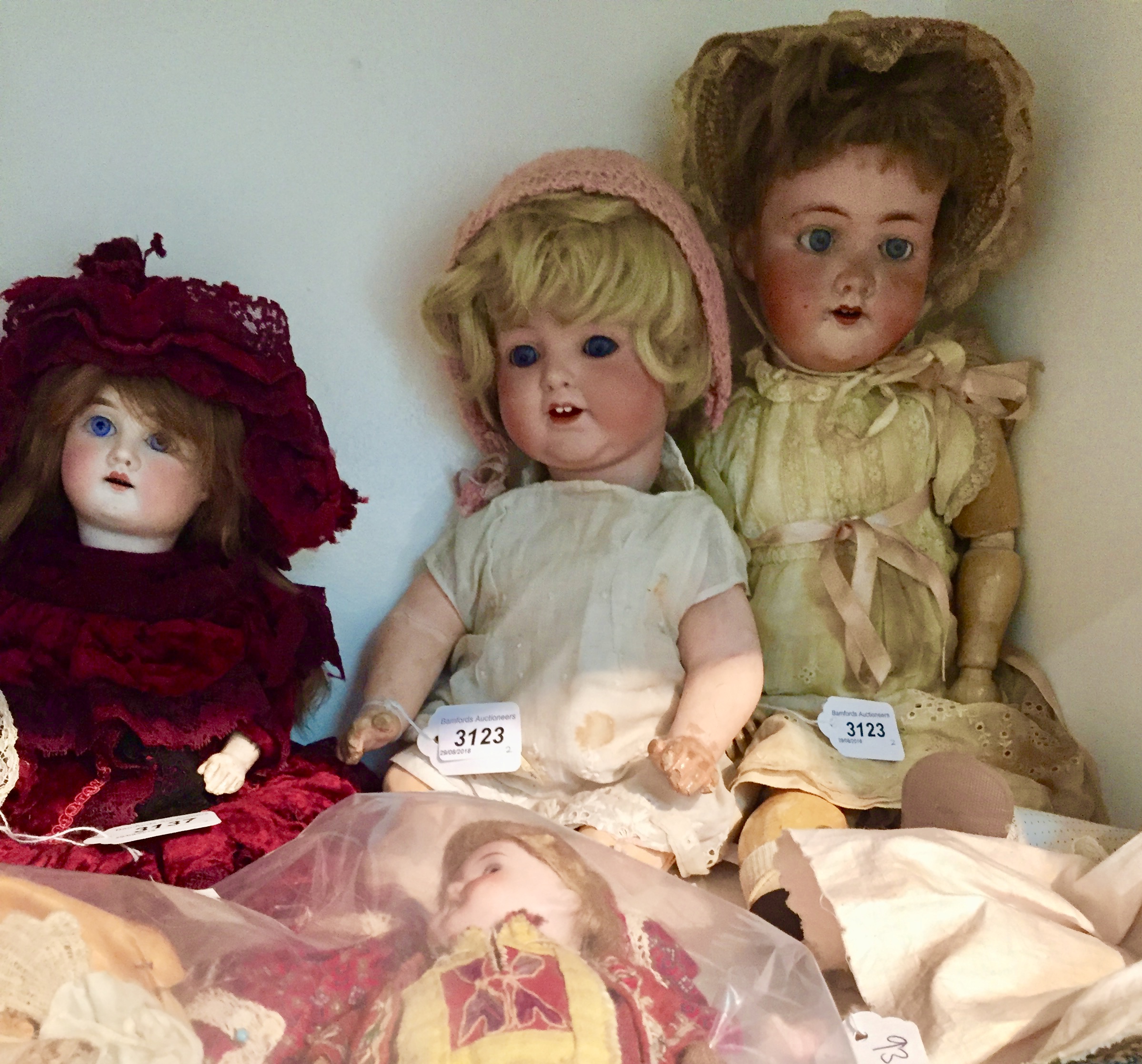
Lot 3123
“Armand Marseille – a 390/6 bisque head socket doll, sleeping blue grey eyes, open mouth, light brown wig, composite body and limbs, impressed marks, creamy white dress, straw bonnet, 55cm long; another smaller 996/7, sleeping blue grey eyes, open mouth, light blond wig, composite body and limbs, impressed marks, creamy white dress, 37cm long – two dolls.”
Armand Marseille are dolls which make which can easily mislead the amateur (me) into parting with lots of money. The name sounds posh, it’s an old company (1885-1950) and the dolls have the stamp of German excellence. However, Armand Marseille was one of the best known and largest manufacturers of bisque dolls; antique expert speak for ‘there’s a lot of them around’. Between 1900-1930, AM produced 1,000 heads per day. When you’re buying in a relatively ‘flat’ market, be sure your model (they’re all from numbered moulds) is rare and in very good condition.
Estimate; £40-60
Sold for: £80
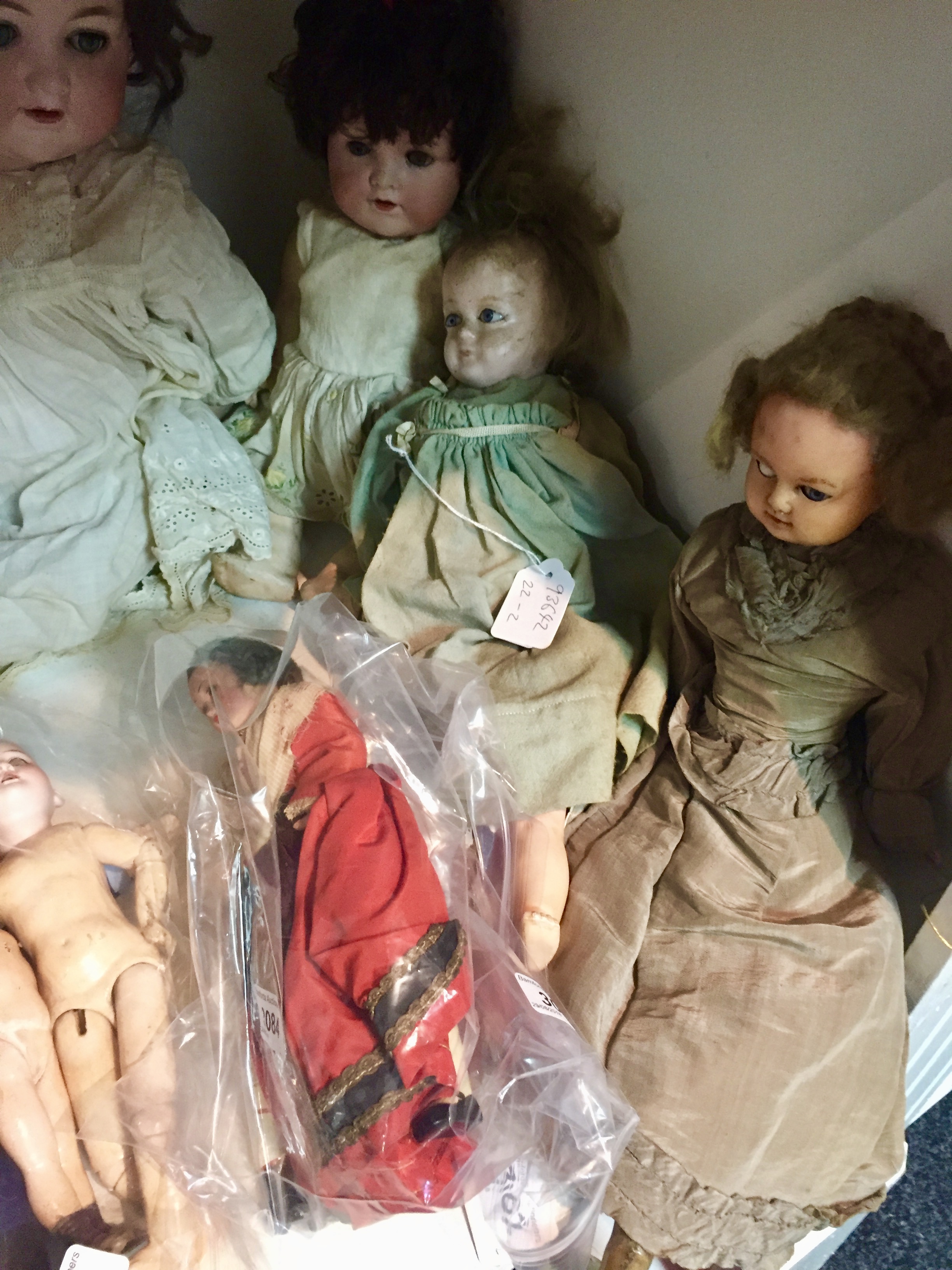
Lot 3102
“A 19th century wax shoulder doll, blue eyes, moulded mouth, light brown wig, cloth body, waxed over lower arms and legs, wearing a grey dress, 43cm high overall; another smaller 20th century, 39.5cm overall – two dolls.’
The lady in grey was typical of the type of doll given to poorer children between 1820 and 1914. According to Mande (my anonymous doll expert) “These wax dolls were the cheapest to make and were mass produced in Germany during the late Victorian period,” she says.
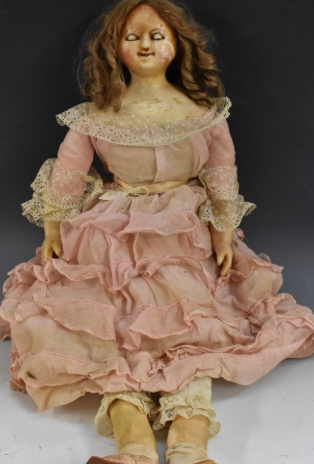 “Beeswax was very, very expensive, so these dolls were made from a composition material (wood pulp/paper) and dipped in wax to give them a thin coating. There was a wax doll to suit every pocket.”
“Beeswax was very, very expensive, so these dolls were made from a composition material (wood pulp/paper) and dipped in wax to give them a thin coating. There was a wax doll to suit every pocket.”
Wax dolls are highly collectable. While the two dolls didn’t achieve their estimated value of £60; an earlier wax doll at the auction (see left) smashed its estimate of £70. It sold for £400 – in spite of being only a shoulder doll (fabric body) and in poor condition.
The reason for big price variations often comes down to how much wax is in the doll (dipped or pure) – and who made it.
“The top echelon were the English poured wax dolls made between 1840 and 1920 using moulds sculpted from scratch by gifted and highly skilled doll sculptors,” Mande explains.
“The finest of these were made by makers such as Montanari and Pierotti. These dolls had beautiful, quality glass eyes, hair inserted in groups of just two or three hairs at a time by a hot needle or scalpel and hand-stitched costumes of fine fabrics such as silk or hand-embroidered cotton. These dolls were only accessible to the wealthiest of families.”
Incidentally, it’s no surprise to find both dolls have blue eyes; according to a Victorian doll maker, grey/blue was the colour of the Queen Victoria’s eyes and English children insisted on this colour in their dolls.
Estimate: £60
Sold for; £55
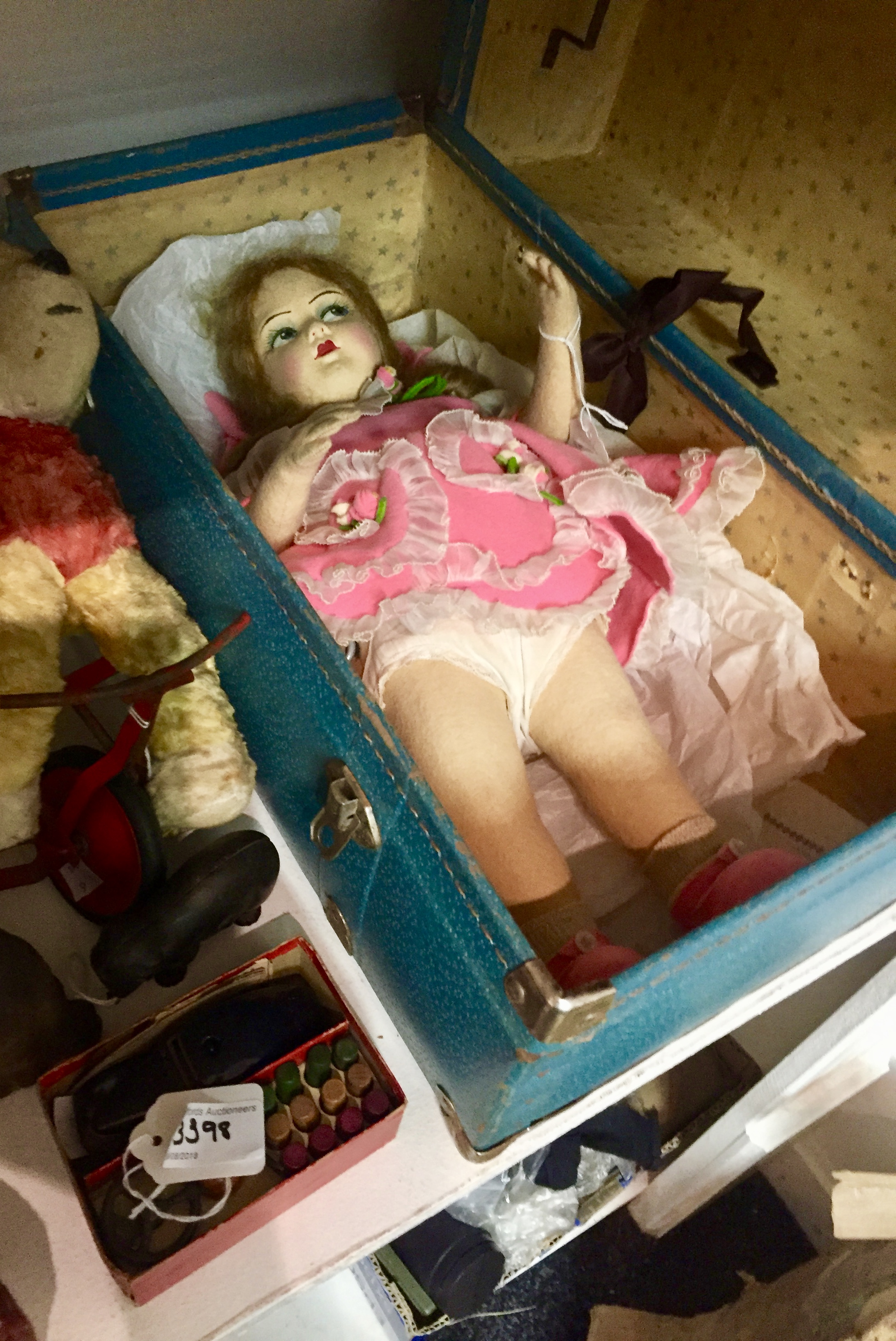
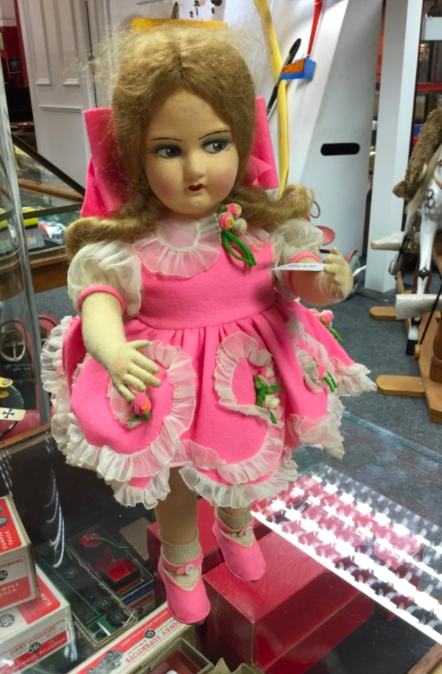
Lot 3079
‘Marrazzi clock work mechanical walking doll – all felt over firm armature body, pressed and painted facial features, blue side-glancing eyes, dark eye shadow, painted upper lashes, single stroke brows, accented nostrils, closed mouth, blonde mohair curls, felt jointed arms, felt legs with hinged hips and hidden wheels under soles of feet, tin soles, vibrant pink felt dress and shoes, white undergarments…’
There was a certain crackle of excitement when this vibrant lady strode into the auction room. If there is one thing guaranteed to up the ante on a doll then it is the addition of a moving part – sleeping eyes, flirty eyes, walking, talking, dancing etc. A clockwork doll can make people go weak at the knees – they’re invariably made by clever watch-makers and feature beautiful components. You’ve hit the jackpot if the doll is working and it has its original key.
Marazzi dolls were known as the ‘walking Lenci’ (Lenci being the Rolls Royce of dolls). This was because of the pressed felt on the body. Marazzi dolls had five working movements. It was both revolutionary and short-lived – due to the financial crisis in 1926, the market for expensive walking dolls collapsed overnight. Understandably, all these factors make the Marazzi doll incredibly desirable.
Estimate: £150-200
Sold for £420

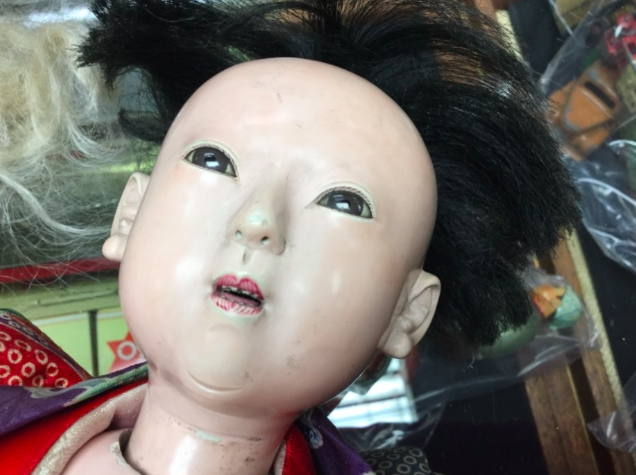 Lot 3135
Lot 3135
‘A mid 20th century Japanese Ichimatsu style boy doll, brown eyes, open mouth, mid length black hair, wooden and composite body, hinged limbs, dressed in a traditional outfit, 30.5cm high.’
Anyone who attends an auction must observe the buyer’s beware principle (see above). In this case Bamfords clearly state the doll is in style of an original doll. But it’s up to the buyer to make sure they don’t get baited into buying too much for a red herring.
A true Ichimatsu doll dates from the 18th Century and these Japanese dolls were made to honour a Kabuki actor Sanogawa Ichimatsu. Original dolls would have been young men with black hair and traditional haircut, with eyes made of glass and dressed in a kimono made of silk. From the late 19th Century, the Ichimatsu style doll was made in the image of children – one popular model being the mischievous-looking boy doll.
Ichimatsu style dolls are highly collectable. Japanese folklore suggests they can come to life and fall in love with their makers – and that their hair can grow.
Estimate; £40-60
Sold for: £200

Lot 3152
‘A German bisque shoulder doll, with moulded hair, blue eyes, 9cm high, c.1910; a half doll, 11.5cm high, marked 3593; – two others. Four dolls.’
According to Mande (my anonymous doll expert) this lot was one every auction attendee dreams about. A sleeper. A miscellaneous lot which concludes with that seemingly dismissive phrase ‘two others’. This is why you must attend auction viewings. You can examine a seemingly perfect doll only to find it is damaged or reproduction but, if you have the necessary experience, you can look at a bundle of unremarkable dolls and realise they are very special indeed.
Here’s what Mande said about lot 3152; “A doll specialist would have the experience to know just what they were. The little group was in fact a very rare bisque lady shoulder-head by Simon and Halbig (one of these dolls, albeit complete with a body, sold at an American auction house for $2500), along with an all-bisque sailor doll produced by the German firm of Hertwig, a good half-doll (pincushion doll) made by Bruno Schmidt and a little late nineteenth century dolls house china head doll in original clothes.”
Estimate; £30-50
Sold for: £300 – a ‘bargain price’ according to Mande.
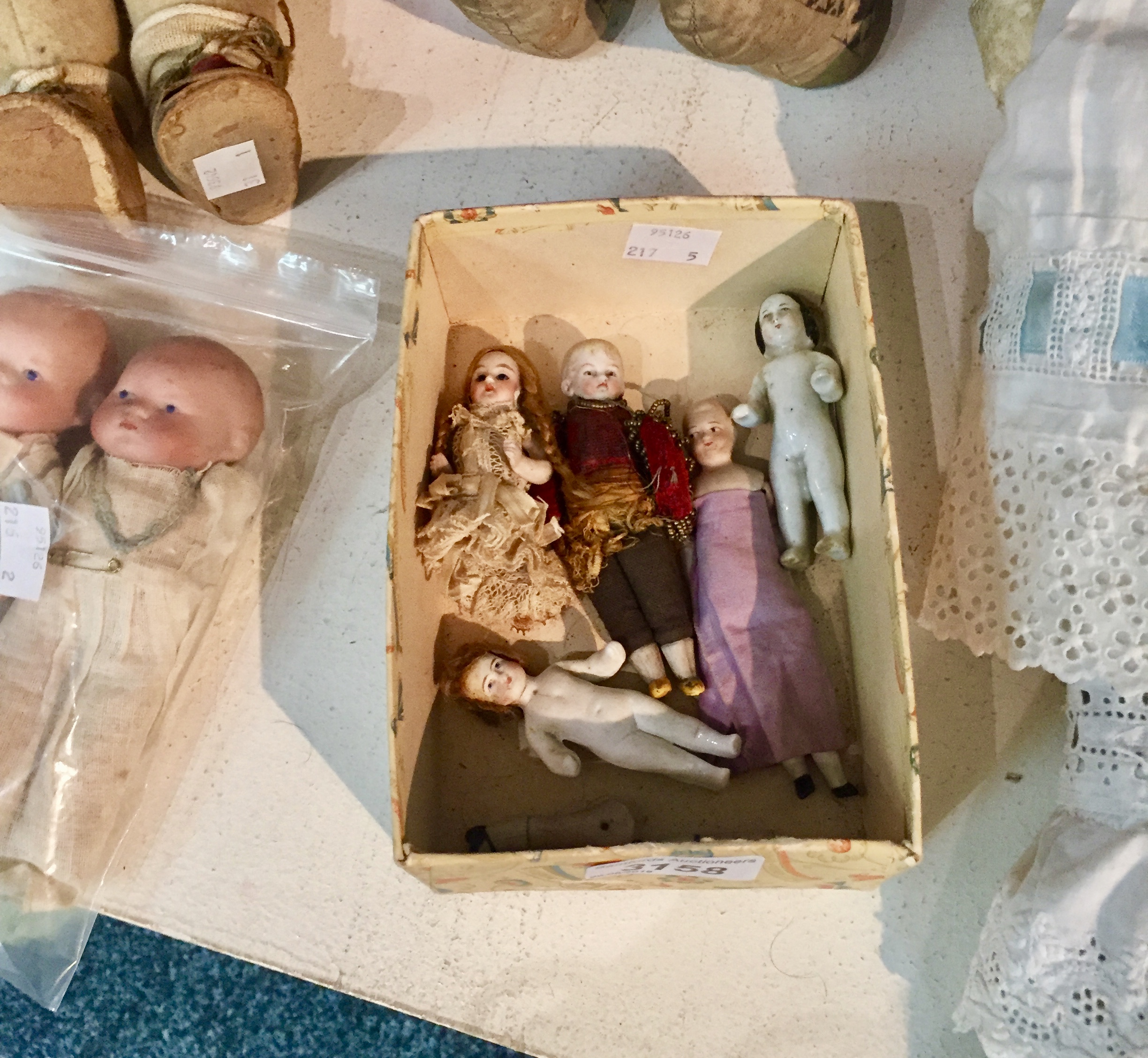
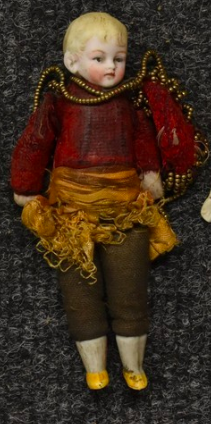
Lot 3158
‘A miniature porcelain boy doll. moulded and painted features, red jacket, brown legs, orange yellow belt, metal beaded hat and chains, pottery hands and feet, unmarked, 10cm long; others German 36/8 girl doll, (legs detached), solid cast pottery pillar dolls etc, smallest 7.5cm long – five dolls.’
Tiny, almost certainly German in origin, the tiny all-bisque dolls (naked) were also known as ‘penny’ dolls – also pillar and Frozen Charlottes – as they were unarticulated (no joints – nothing to do with lorries) and made from a single piece of porcelain.
They are more valuable today because – being fragile – they rarely survive in one piece. The desirable lots in this box are the two dressed dolls and the shoulder doll (quite simply; a doll with a head and shoulders). Miniature dolls – suitable for doll’s houses – are really big in the antique world and the boy figure (left) has fine features and a nicely preserved costume.
Estimate; No Estimate
Sold for: £200
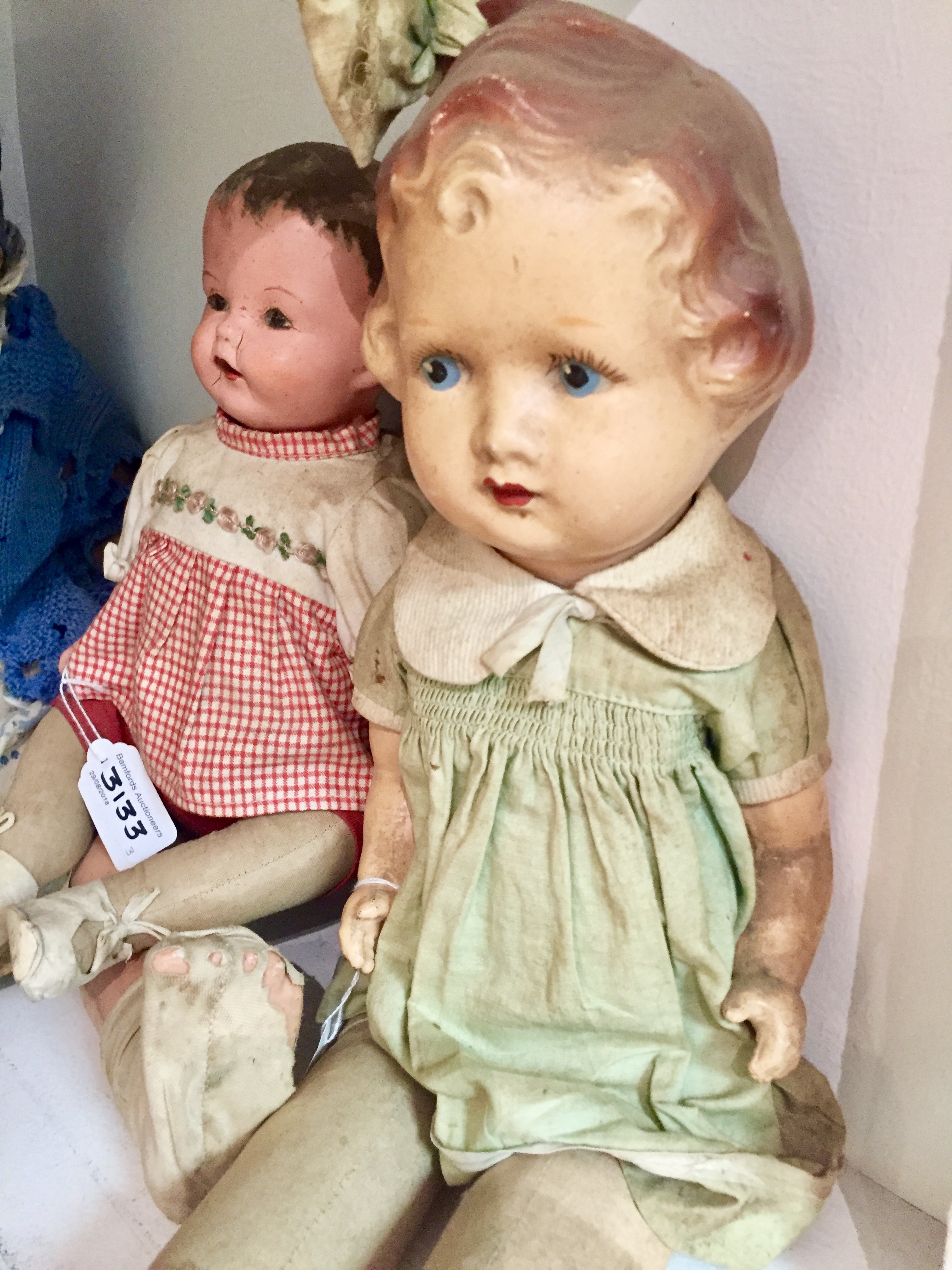
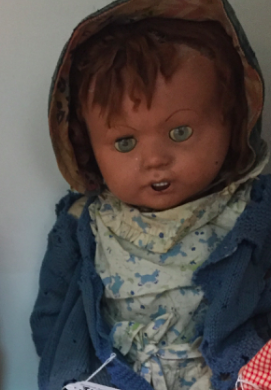 Lot 3133
Lot 3133
‘A large composite walking doll, swivel head action, sleeping blue eyes, open mouth, brown wig, composite body and limbs, floral dress, unmarked; 74cm high; others smaller, cloth bodies, 53cm and 32cm – three dolls.’
Funnily enough, this little blonde glamour puss (top right) really caught my eye. There was something about her grubby state which made me want to take her home and give her a hot soapy bath and a cuddle. But here’s a thing, the room was full of doll experts and this lot had been viewed by doll collectors around the world. Their verdict? Strike out – zero interest. Why? For starters, the dolls are in poor condition. They are unmarked and the main doll – a composite walking doll – isn’t that old. And it’s scary.
Estimate; £40-60
Sold for; The lot didn’t meet it’s reserve – no sale
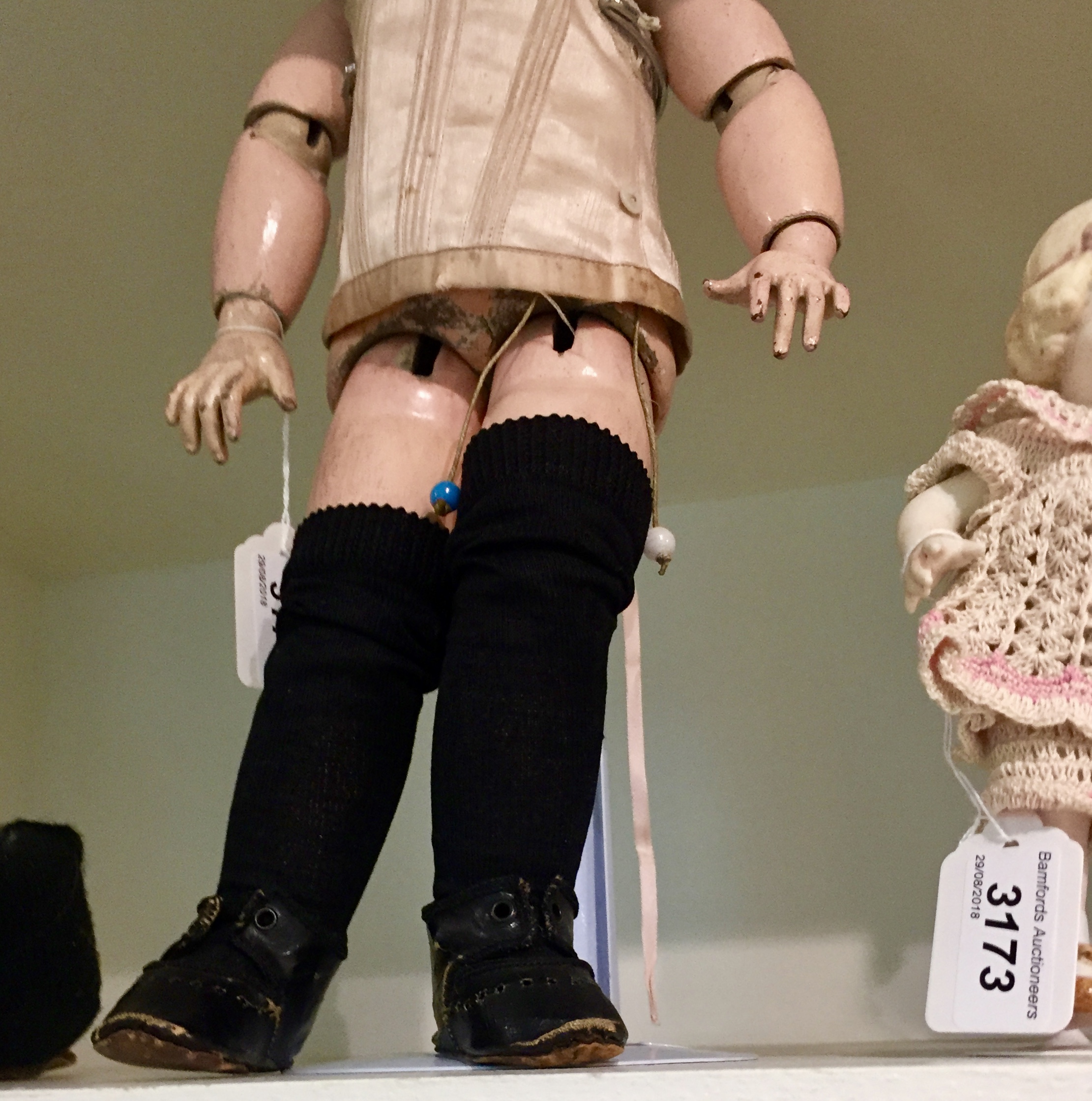
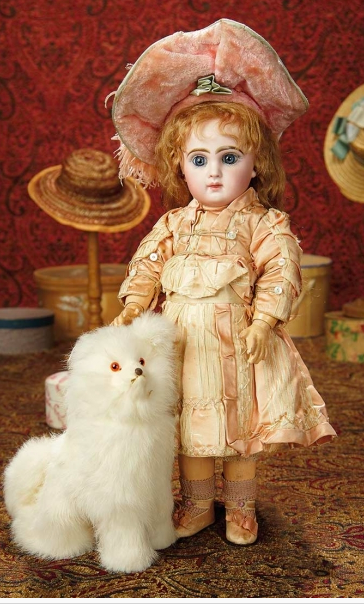 Lot 3172
Lot 3172
What? Jumeau – a Bebe composite body, labelled Beebe Jumeu Diplome d’Honneur, with voice box, corset, black stocking and shoes, 34.5cm long
I know what you’re thinking – I’ve cut the poor head from my poor dolly. I promise you, this lot was sold in a headless condition. The reasons it’s still head and shoulders (well, shoulders) above the rest of the dolly tribe is because it’s by Pierre François Jumeau (1811-1895). His beautiful bisque doll are adored by collectors…
Jumeau’s early works aren’t even considered to be dolls; they are works of art. The Diplome d’Honneur refers to the body used in the construction of this doll.
They were acclaimed and award-winning examples of their art during Jumeau’s life-time and they’ve become more famous with age. If you’re in any doubt as to the worth of a headless doll – a mint condition one (pictured left) sold for $11,000.
Estimate: £40-60
Sold for: £220
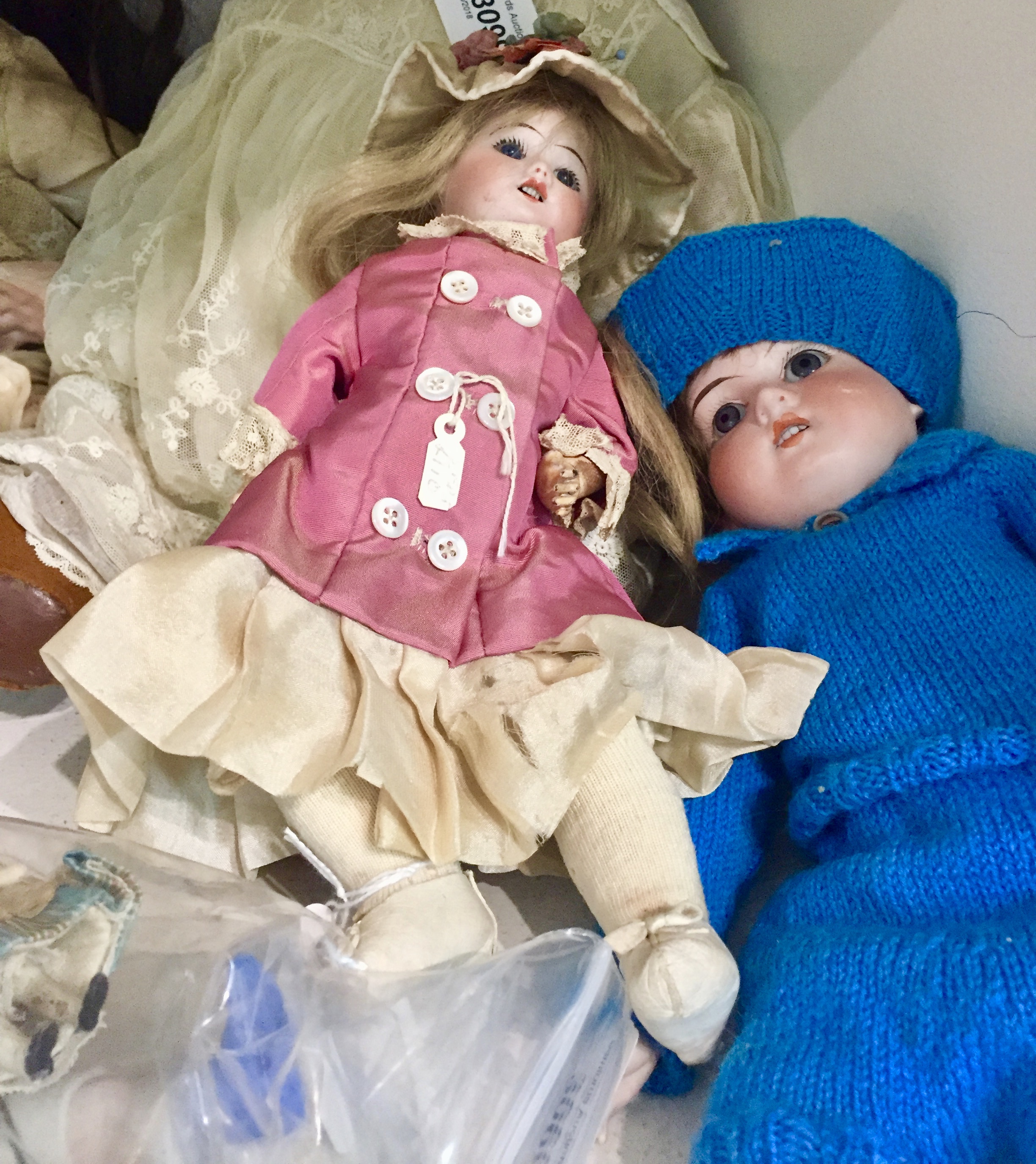
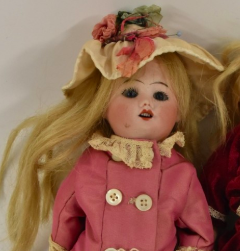 Lot 3127
Lot 3127
‘SFBJ French bisque porcelain socket head doll, fixed blue eyes, open mouth with teeth, painted features, long blond wig, faint impressed marks, possibly mould No 60, white dress, pink and white coat and bonnet, 30cm long; another similar smaller 28cm long – two dolls (the other is not pictured).’
SFBJ is the short-hand for ‘Société Française de Fabrication de Bébés et Jouets‘. Launched at the tail end of the great French doll-making era, it spanned the end of the 19th Century until 1960. SFBJ was formed from the remnants of many great French doll makers – including the legendary Jumeau. Collectors are often on the look-out for early dolls which could turn out to be ‘Jumeau’ by another name. Prices remain steady, even a little on the up, for the early, rare dolls. Common moulds numbers can be found at a low prices. Collectors should look out for the Bluette, so popular she’s often called the Barbie of her day.
Estimate; £40-60
Sold for; £95

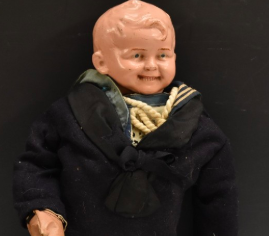 Lot 3116
Lot 3116
‘A hand made composite head Sailor Boy doll, painted blue eyes, smiling mouth, moulded hair, wearing a traditional outfit, lacking hat, unmarked, 55cm long; another smaller Norah Wellings R.M.S Queen Mary doll with life ring, unlabelled, 21cm long – two dolls.’
Another auction lesson to be learned here. Don’t just look at the big, attention grabbing item/doll – look at all the smaller items or dolls; they might just be the interesting/valuable part of the lot. This sailor boy (left) was unmarked and of cheap composite material. However, the tiny sailor boy at his feet was made by Chad Valley’s famous recruit Norah Wellings (1893-1975). Norah established her own toy works in 1926 with her brother, selling her very distinctive dolls with their cloth faces (sometimes velvet or velveteen) – and they sometimes represent fictional characters.
The RMS Queen Mary doll is one of a souvenir range manufactured for sale on cruise ships before WWII. As such, it’s not such a rare doll – but Norah has her followers. All Norah Wellings pre-date 1959 and there will be no more. Sadly, just months after the death of her beloved brother, Wellings closed the business and destroyed all her designs and unfinished dolls. Wellings dolls are certainly ones to keep an eye on…a rare PJ case from the 1930s sold for £148 on Ebay (August 2018).
Estimate; £40-60
Sold for; £30
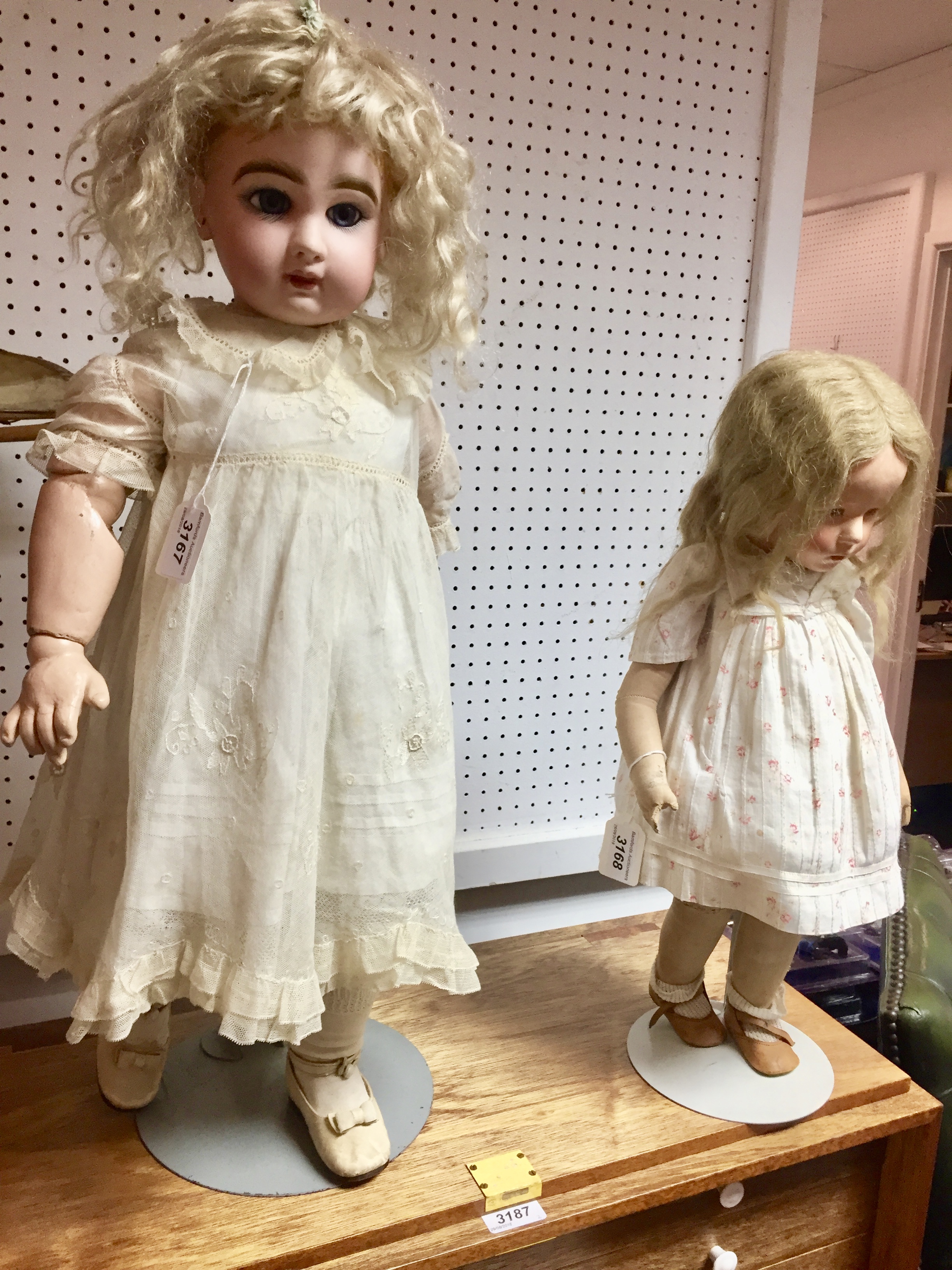
 Lot 3167
Lot 3167
Jumeau – a Tete Bebe, bisque porcelain head doll, fixed blue eyes, closed mouth, blond hair, composite body and limbs, white dress and under garments, signed Depose Tete Jumeau Bte S.G.D.G / L12 HII, impressed roundel, 65cm high.
What? You only have to read about the headless doll – number seven – to realise Jumeau is a magic word, capable of casting a spell on doll collectors throughout the world.
The French doll on the left is the equivalent of having a celebrity like Brigette Bardot in the room. Despite her advanced year, she’ll still turn heads. The bebe doll range had common features – bisque head, jointed, paperweight eyes – but they had a myriad of costumes, sizes and features; there’s even a phonographic one which speaks and tells jokes. The most highly prize dolls date from the 19th Century (Jumeau died in 1895). A lot of the ‘bebe’ doll made after this period are of such an inferior quality; even a non-experts (me) would be able to tell the difference.
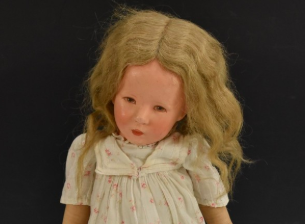 Margaret Whitton, author of The Juneau Doll, explains the appeal.
Margaret Whitton, author of The Juneau Doll, explains the appeal.
“(They were) unsurpassed models of luxury, grace, elegance and mechanical invention. What’s more they wore the finest French fashions created by true fashion designers.”
These dolls are rare and a mint condition figure could be worth thousands.
Estimate £80-120
Sold for: £900
PS; if you’re thinking you’d prefer the sweet doll on the right (me again) then you have very good taste. She’s a Kathe Kruse doll, handmade and painted onto canvas. She made £480 at auction.
* The hammer price does not include the 21% commission charge on every sale and the VAT paid on every lot. For example, a doll costing £1,000 will mean £1,252 is payable to the auction house.
The dolls were all sold at;- Bamfords Specialist Toy and Juvenalia Sale on August 29th 2018
Call (01332) 210 000 for details of forthcoming sales or visit Bamfords Auctioneer & Valuers


